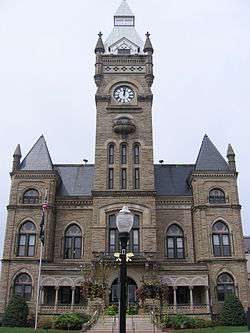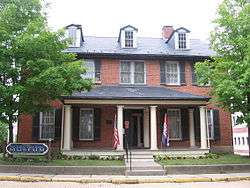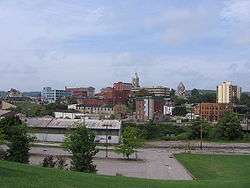Butler, Pennsylvania
| Butler, Pennsylvania | |
|---|---|
| City | |
|
View of Butler from the Southside neighborhood | |
 Location of Butler in Butler County, Pennsylvania. | |
 Butler Location within the state of Pennsylvania | |
| Coordinates: 40°51′38″N 79°53′41″W / 40.86056°N 79.89472°WCoordinates: 40°51′38″N 79°53′41″W / 40.86056°N 79.89472°W | |
| Country | United States |
| State | Pennsylvania |
| County | Butler |
| Settled | 1802[1] |
| Incorporated (borough) | 1816[1] |
| Incorporated (city); | 1918[1] |
| Government | |
| • Type | Mayor-Council |
| • Mayor | Thomas P. Donaldson (R) |
| Area[2] | |
| • Total | 2.72 sq mi (7.04 km2) |
| • Land | 2.72 sq mi (7.04 km2) |
| • Water | 0.00 sq mi (0.00 km2) |
| Population (2010) | |
| • Total | 13,757 |
| • Estimate (2016)[3] | 13,155 |
| • Density | 4,838.18/sq mi (1,868.26/km2) |
| Time zone | Eastern (EST) (UTC-5) |
| • Summer (DST) | EDT (UTC-4) |
| Zip code | 16001, 16002, 16003 |
| Area code(s) | 724 |
| FIPS code | 42-10464 |
| Website |
cityofbutler |
Butler is a city and the county seat of Butler County in the U.S. state of Pennsylvania.[4] It is located 35 miles (56 km) north of Pittsburgh and part of the Pittsburgh metropolitan area. As of the 2010 census, the city population was 13,757.[5] Butler was named the 7th best small town in America by Smithsonian magazine in May 2012.[6]
History

Butler was named for Maj. Gen. Richard Butler,[7] who fell at the Battle of the Wabash, also known as St. Clair's Defeat, in western Ohio in 1791.
In 1803 John and Samuel Cunningham became the first settlers in the village of Butler. After settling in Butler, the two brothers laid out the community by drawing up plots of land for more incoming settlers.[7] By 1817, the community was incorporated into a borough.[7] The first settlers were of Irish or Scottish descent and were driving westward from Connecticut. In 1802 the German immigrants began arriving, with Detmar Basse settling in Jackson Township in 1802 and founding Zelienople the following year. After George Rapp arrived in 1805 and founded Harmony, larger numbers of settlers followed. John A. Roebling settled Saxonburg in 1832, by which time most of the county was filled with German settlers.
Rail and automobile
Throughout most of its history, the city of Butler has been a major manufacturing and industrial center. In 1902, the Standard Steel Car Company opened one of its largest railcar manufacturing facilities in Butler. It was here that some of the first all-steel rail cars were built. Diamond Jim Brady, the legendary financier, gourmand and gemophile, got his start here in 1902 when he established the Standard Steel Car Company, which merged with the Pullman Palace Car Company in 1934 to create Pullman-Standard, a monopoly that was eventually broken by the government.
About 2,500 workers produced 60 steel-bed railroad cars per day in 1902. Eastern European immigrants from Eastern Europe were attracted to the area in the early 20th century by the reliable jobs which sometimes included rent-free company housing. The company constructed a baseball park which was the home of a New York Yankees farm team. It made artillery and naval shells during World War II.[8]
The Pullman-Standard plant closed in 1982, and was demolished in 2005. The site is now occupied by a strip mall, as well as the new Butler Transit Authority intermodal facility. In 2011 the BTA moved a covered hopper railcar to the bus terminal in recognition of the former Pullman-Standard plant. The car was built at the facility in 1974.[9]
The American Austin Car Company (1929–41) was also headquartered in the borough. Later the firm changed its name to American Bantam Car Company. Bantam was an early producer of small fuel-efficient vehicles through the 1930s. The modern Jeep was created by American Bantam and the first prototypes were manufactured at the Butler facility. Big military contracts eventually went to Willys and Ford, while the Bantam factory had failed by World War II. Today, a monument in the plaza across from the courthouse commemorates Bantam's creation of the Jeep.
Butler is home to one of the early Ford dealerships, established in 1918 and still extant.[10]
The Rainbow Rubber Company, which in the late 1930s made precise "Rubrtoy" replicas of Oldsmobiles along with many other rubber toys was also located in Butler.[11]
In the 1950s, Butler became one of the first cities to install bells at crosswalks, a common practice today.
The city was linked to Pittsburgh via Mars, Pennsylvania, in 1907 by the Pittsburgh and Butler Street Railway, and to Evans City in 1908 by the Pittsburgh, Harmony, Butler and New Castle Railway, both interurban trolley lines. The Mars route closed in April 1931, followed by the Evans City line on August 15, 1931, with the trolleys replaced by buses.
Since the 1970s the borough's economy has changed drastically. Manufacturing has declined and good paying jobs are much rarer.[8]
Geography
According to the United States Census Bureau, the city has a total area of 2.7 square miles (7.0 km2), all land.
The Connoquenessing Creek, which was ranked the second most polluted waterway in the U.S. in 2000, flows through the city.[12]
Demographics
| Historical population | |||
|---|---|---|---|
| Census | Pop. | %± | |
| 1820 | 225 | — | |
| 1830 | 580 | 157.8% | |
| 1840 | 861 | 48.4% | |
| 1850 | 1,148 | 33.3% | |
| 1860 | 1,399 | 21.9% | |
| 1870 | 1,935 | 38.3% | |
| 1880 | 3,163 | 63.5% | |
| 1890 | 8,734 | 176.1% | |
| 1900 | 10,853 | 24.3% | |
| 1910 | 20,728 | 91.0% | |
| 1920 | 23,778 | 14.7% | |
| 1930 | 23,568 | −0.9% | |
| 1940 | 24,477 | 3.9% | |
| 1950 | 23,482 | −4.1% | |
| 1960 | 20,975 | −10.7% | |
| 1970 | 18,691 | −10.9% | |
| 1980 | 17,026 | −8.9% | |
| 1990 | 15,714 | −7.7% | |
| 2000 | 15,121 | −3.8% | |
| 2010 | 13,757 | −9.0% | |
| Est. 2016 | 13,155 | [3] | −4.4% |
As of the census[13] of 2000, there were 15,121 people, 6,740 households, and 3,626 families residing in the city. The population density was 5,611.3 people per square mile (2,170.4/km²). There were 7,402 housing units at an average density of 2,746.8 per square mile (1,062.4/km²). The racial makeup of the city was 93.6% White, 2.7% African American, 0.2% Native American, 0.5% Asian, 0.52% from other races, and 1.14% from two or more races. Hispanic or Latino of any race were 4.88% of the population.
There were 6,740 households, out of which 26.8% had children under the age of 18 living with them, 35.0% were married couples living together, 14.4% had a female householder with no husband present, and 46.2% were non-families. 40.7% of all households were made up of individuals, and 16.3% had someone living alone who was 65 years of age or older. The average household size was 2.18 and the average family size was 2.96.
In the city, the population was spread out, with 23.7% under the age of 18, 9.7% from 18 to 24, 30.3% from 25 to 44, 20.2% from 45 to 64, and 16.1% who were 65 years of age or older. The median age was 36 years. For every 100 females there were 88.1 males. For every 100 females age 18 and over, there were 83.9 males.
The median income for a household in the city was $25,154, and the median income for a family was $35,893. Males had a median income of $30,607 versus $20,950 for females. The per capita income for the city was $16,457. About 14.7% of families and 19.1% of the population were below the poverty line, including 26.8% of those under age 18 and 14.5% of those age 65 or over.
Economy
Major employers:
- AK Steel
- Armstrong Group of Companies
- Penn United Technologies
- VA Butler Healthcare
- Butler Area School District
- Butler Health System
Sites of interest


- The Butler County Courthouse is a government and judicial building located in the heart of the city. The structure is listed on the National Register of Historic Places. The plaza across the street from the courthouse displays many interesting war and other memorials.
- The Sen. Walter Lowrie House was the home of United States Senator Walter Lowrie, built in 1828. It is currently maintained as a museum, and is the headquarters of the Butler County Historical Society. The house is on the National Register of Historic Places.
- The Maridon Museum, located in downtown Butler, is the only museum in the Western Pennsylvania region with a specific focus on Chinese and Japanese art and culture.
- Kelly Automotive Park (formerly known as Pullman Park until 2014), built in 1934, was used for minor league baseball for twenty years until the Pittsburgh Pirates farm team left in 1951. The ballpark saw many famous faces during its professional baseball days, including Lou Gehrig, Whitey Ford, and Joe DiMaggio, who played for a farm team of the New York Yankees. Rebuilt in 2008, the stadium is currently the home of the Butler BlueSox.
Neighborhoods
- Institute Hill
- The Island
- South Side
- North Butler
- The Boulevard
- West End
- South Hills
- Whippo
Education
- Butler Area School District
- Allegheny-Clarion Valley Joint Schools
- Freeport Area School District
- Karns City Area School District
- Mars Area School District
- Moniteau School District
- Slippery Rock Area School District
- South Butler County School District
- Seneca Valley School District
- Butler County Area Vocational-Technical School
- Butler County Community College (Pennsylvania)
- Slippery Rock University of Pennsylvania
Culture
Live plays are performed by local actors at the historic Butler Little Theatre, which has been running productions continuously since 1941. The Musical Theater Guild also produces an annual musical production. In 2012, Hobnob Theatre Company began producing several plays, including an annual production of Charles Dickens' A Christmas Carol.
A handful of local authors have written various novels and books on the surrounding area. Stewart O'Nan's prizewinning novel Snow Angels is set in Butler. The city was the setting for several scenes in Benjamin's Field, a fictional trilogy by local author J. J. Knights that was published in 2015.[14]
Butler is home to the Butler County Symphony Association, which performs at the Butler Intermediate High School auditorium. There are also many art groups located in the city. They include the Associated Artists of Butler County and the Butler Arts Council. Several murals have been painted on exposed walls by local artists.
Leisure activities
Butler Road Race, a 5-mile and 2-mile race held each summer in June, raises funds for local students in scholarships.
The Butler Fall Festival, held each September, features car shows, ethnic foods, and many representative items from various cultures.
Bantam Jeep Heritage Festival, the Largest Jeep Festival in the USA, is held annually in June with off-road trails, a Jeep Playground obstacle course, and the original Jeep Invasion street party.
Sports
- Butler BlueSox, Prospect League
- Butler County Bears, Heartland Football League
- Butler Area Softball League
- Butler Sports League
Transportation
Airports

There are two airports located outside the city. Butler County Airport is used for general aviation, and can accommodate large aircraft such as corporate jets. Butler Farm Show Airport is used by pilots with smaller, private aircraft in the Butler area.
Mass transit
Butler is served by The Bus, run by the Butler Transit Authority.
Railroads
Two railroads currently offer freight service in Butler. The Canadian National Railway-owned Bessemer and Lake Erie Railroad main line passes through the city, while the Buffalo and Pittsburgh Railroad provides regional service in the area. The B&P has a large locomotive shop located just outside the city limits.
Roads
Five major highways run through or near the city, providing links to other areas throughout western Pennsylvania. The south terminus of Pennsylvania Route 38 is just north of the city at U.S. Route 422. Route 422 skirts the city to the north on the Butler Bypass. PA 68 and PA 356 go straight through downtown, where they intersect with PA 8, Butler's Main Street when passing through the city.
Media
- Butler Dispatch
- Butler Eagle daily newspaper
- WBUT
- WISR
- WLER-FM
- Butler Radio Network
Notable people
- Rich Bartlewski, pro football player, born in Butler
- Judge William G. Bassler, formerly of United States District Court for the District of New Jersey
- Josie Carey, the host of The Children's Corner on WQED in Pittsburgh, was one of the first employees of the station, which was the first community-sponsored public TV station. Fred Rogers was a puppeteer and musician on her show for seven years before creating Mister Rogers' Neighborhood; born and raised in Butler.
- Joan Chandler, actress, born in Butler
- Matt Clement, former Major League Baseball pitcher, All-Star, member of 2007 World Series champion Boston Red Sox
- Harold Dodds, president of Princeton University
- Barbara Feldon, film and television actress, Agent 99 of the TV series Get Smart, born in Butler
- Grace Gealey, actress, Anika on the TV series Empire
- Khalil Greene, former Major League Baseball player, born in Butler
- Admiral Jonathan W. Greenert, Chief of Naval Operations, US Navy
- Terry Hanratty, All-American quarterback from Notre Dame who won the National Championship in 1966 and went on to play for the Pittsburgh Steelers during the 1970s as a backup; born in Butler in 1948
- Jake Hildebrand, hockey player
- Harry Holiday, world record-setting swimmer and Armco CEO, born and raised in Butler
- Don Kelly, utility player for the Detroit Tigers of Major League Baseball
- Klutinoty Brothers, of Christian rock band About a Mile
- Jay Last, member of the Traitorous Eight, founding father of Silicon Valley
- Michele McDonald, Miss USA 1971
- Jerry Meals, Major League Baseball umpire
- Todd Tamanend Clark, poet and composer, lived in Butler from 1972 to 1992
- Bret Michaels, lead singer of Poison, born in Butler but raised in Mechanicsburg, Pennsylvania
- Jonathan Scialabba, actor noted for roles in Outsiders (U.S. TV series), Marshall (film), and Those Who Kill (U.S. TV series)
- Fred McCarren (1951-2006), notable character actor featured in numerous commercials, television, and film.
- Scott Milanovich (Maryland, '96), former NFL quarterback and current head coach of the Canadian Football League's Toronto Argonauts
- Brian Minto, heavyweight boxer
- John Minton (1948–1995), wrestler known by name Big John Studd
- Eric Namesnik (1970–2006), two-time silver medalist Olympic swimmer
- Michele Pawk, Tony Award-winning actress, born and raised in Butler
- William J. Perry, Secretary of Defense under Bill Clinton (1994–97), born in Vandergrift, graduated from Butler High School in 1945
- Paul Posluszny, Jacksonville Jaguars linebacker and All American Penn State University linebacker, born in Butler
- Jim Pugh, jazz trombonist and arranger, born and raised in Butler
- William Purvis, French horn player, born and raised in Butler
- Rick Santorum, former U.S. senator, spent his formative years in Butler
- Bill Saul and his twin brothers Rich Saul and Ron Saul, professional football players during the 1960s and 1970s, born and raised in Butler
- Scot Thompson, born and raised in Butler, played Major League Baseball with the Cubs, Giants and Expos
- Ed Vargo, Major League Baseball umpire, born in Butler
- Samuel Hall Young, prominent Alaska Presbyterian missionary, born and raised in Butler
References
- 1 2 3 "Butler County, 5th class" (pdf). Pennsylvania Historic and Museum Commission. Retrieved January 15, 2010.
- ↑ "2016 U.S. Gazetteer Files". United States Census Bureau. Retrieved Jul 4, 2017.
- 1 2 "Population and Housing Unit Estimates". Retrieved June 9, 2017.
- ↑ "Find a County". National Association of Counties. Archived from the original on May 31, 2011. Retrieved 2011-06-07.
- ↑ "Geographic Identifiers: 2010 Demographic Profile Data (G001): Butler city, Pennsylvania". U.S. Census Bureau, American Factfinder. Retrieved March 21, 2014.
- ↑ 20 Best Small Towns in America; Smithsonian Magazine; May 2012
- 1 2 3 An Historical Gazetteer of Butler County, Pennsylvania, p. 118
- 1 2 Viser, Matt (September 1, 2016). "In Pa., Boomers see the American dream slipping away". Boston Globe. Retrieved September 4, 2016.
- ↑ Garrett, Kelly B. (February 4, 2011). "Pullman railcar honors past". Butler Eagle.
- ↑ "Dealer Profile". Butler County Ford. Retrieved April 28, 2014.
- ↑ "Rainbow Rubber Co 1935 Oldsmobile Coupe". WorthPoint. July 7, 2011. Retrieved April 28, 2014.
This Oldsmobile Coupe was made by Rainbow Rubber Co. circa 1935. At 3 3/4 inches long by 1 3/8 inches wide, it is made of rubber... Underneath it is marked 'Rubrtoy Oldsmobile Mfg'd by Rainbow Rubber Co. Butler, PA.'.
- ↑ "Pa. ranks 2nd worst in toxic dumping". Pittsburgh Post-Gazette. February 18, 2000. Retrieved November 7, 2010.
- ↑ "American FactFinder". United States Census Bureau. Archived from the original on September 11, 2013. Retrieved 2008-01-31.
- ↑ http://www.butlereagle.com/article/20150730/ARTSENTERTAINMENT02/707309915
Further reading
- Brown, Robert C. History of Butler County, Pennsylvania:...Pioneers and Representative Citizens, Etc., Etc. [Chicago]: R.C. Brown & Co., 1895. Chapter VI.Print.
- An Historical Gazetteer of Butler County, Pennsylvania, Chicora: Mechling Bookbindery, 2006, ISBN 978-0-9760563-9-3.
External links
| Wikimedia Commons has media related to Butler, Pennsylvania. |
| Wikisource has the text of the 1911 Encyclopædia Britannica article Butler (Pennsylvania). |
- City of Butler official website
- Butler County Historical Society
- Butler Area Public Library
- Butler Area School District
- 1883 History of Butler County

